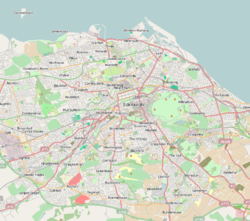| East Claremont Street drill hall | |
|---|---|
| Edinburgh, Scotland | |
 East Claremont Street drill hall | |
| Coordinates | 55°57′47″N 3°11′31″W / 55.96304°N 3.19201°WCoordinates: 55°57′47″N 3°11′31″W / 55.96304°N 3.19201°W |
| Type | Drill hall |
| Site history | |
| Built | 1912 |
| Built for | War Office |
| Architect | Thomas Duncan Rhind |
| In use | 1912 – Present |
| Garrison information | |
| Occupants |
A (Royal Scots Borderers) Company, 52nd Lowland, 6th Battalion The Royal Regiment of Scotland Lowland Band of the Royal Regiment of Scotland |
The East Claremont Street drill hall is a military installation in Edinburgh.
History[]
The building was designed by Thomas Duncan Rhind in the free Renaissance style as the headquarters of the 9th (Highlanders) Battalion the Royal Scots and completed in 1912.[1] The battalion was mobilised at the drill hall in August 1914 before being deployed to Western Front.[2]
The battalion amalgamated with the 7th Battalion to become the 7th/9th (Highlanders) Battalion, The Royal Scots, with its headquarters at the Dalmeny Street drill hall but with elements at the East Claremont Street drill hall, in 1922.[3] The 7th/9th Battalion and the 8th Battalion amalgamated to form the 8th/9th Battalion, still at the Dalmeny Street drill hall but with representation at the East Claremont Street drill hall, in 1961.[3] The 8th/9th Battalion was reduced to company size as A (Royal Scots) Company, the 52nd Lowland Volunteers in 1967 and this unit in turn evolved to become HQ (Royal Scots) Company, Lowland Volunteers in 1995.[4]
After the Dalmeny Street drill hall was decommissioned in the late 1990s, this unit, in its new designation as A (Royal Scots) Company, 52nd Lowland Regiment, became based at the East Claremont Street drill hall in 1999.[4] This unit evolved further to become A (Royal Scots Borderers) Company, 52nd Lowland, 6th Battalion The Royal Regiment of Scotland, still based at the East Claremont Street drill hall, in 2006.[4] The building, which is known as Hepburn House after Sir John Hepburn, founder of the Royal Scots, remains an active Army Reserve Centre.[5]
References[]
- ↑ "Edinburgh, 89 East Claremont Street, Drill Hall". Canmore. https://canmore.org.uk/site/333065/edinburgh-89-east-claremont-street-drill-hall. Retrieved 12 June 2017.
- ↑ "The Royal Scots". The Long, Long Trail. http://www.longlongtrail.co.uk/army/regiments-and-corps/the-british-infantry-regiments-of-1914-1918/royal-scots-lothian-regiment/. Retrieved 21 May 2017.
- ↑ 3.0 3.1 "The Territorial Army". Royal Scots. http://www.theroyalscots.co.uk/the-territorial-army/. Retrieved 11 June 2017.
- ↑ 4.0 4.1 4.2 "Lowland Volunteers". British Army units 1945 on. http://british-army-units1945on.co.uk/territorial-army-infantry/lowland-volunteers.html. Retrieved 11 June 2017.
- ↑ "A (Royal Scots Borderers) Company". Ministry of Defence. http://www.army.mod.uk/infantry/regiments/26935.aspx. Retrieved 11 June 2017.
The original article can be found at East Claremont Street drill hall and the edit history here.
